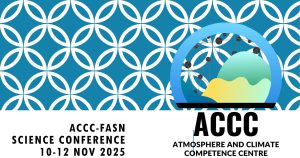Project Description

The Atmosphere and Climate Competence Centre (ACCC) & Finnish Atmospheric Science Network (FASN) Science Conference took place during 10-12 November 2025 (Helsinki, Finland) at the premises of the University of Helsinki and the Finnish Meteorological Institute. In total, more than 250 persons attended the conference onsite. The conference included multiple invited talks and oral presentations during plenary sessions including 2 poster sessions. A series of presentations (orals and posters) from the PEEX collaborating partners – Jordan, Denmark, Latvia, Norway, Ukraine – was delivered during the conference.
The oral presentation on “Climate Change and Northern Cities: Hazards, Processes, Impacts, Risks and Solutions for Resilient and Sustainable Developments” by Prof. Alexander Baklanov from the University of Copenhagen (UCPH, Denmark) focused on opinion and expectation that global warming is positive for northern cities and does not pose a risk, and it is far from true and requires careful analysis. Arctic and high-latitude cities are much more vulnerable to the climate change and extreme events. Northern cities split naturally into several risk archetypes: permafrost-dominated, coastal/ estuarine, and temperate/ pluvial/ urban heat island (UHI). There were several attempts to study some separate aspects of the problem, but a complex multidisciplinary analysis is needed. There is a strong knowledge gap in understanding specific problems of climate change consequences for northern cities including risks, challenges, optimal ways for mitigations and adaptation to climate change and strategy for their climate-smart, resilient and sustainable development.
The oral presentation on “Application of the Local Climate Zone Concept in Multi-Scale Model Studies of Urban Micro-Climates” by Prof. Igor Esau from the Arctic University of Norway (UiT, Norway) focused on preliminary results supporting the idea that local climate zones (LCZs) could be used not only for thermal climate characterization but also more holistically for description of urban atmospheric dynamics and vertical mixing, and therefore urban air pollution dispersion.
The poster on “Urban Heat Island Investigation over Copenhagen Metropolitan Area with Enviro-HIRLAM” by Dr. Maher Sahyoun from the University of Copenhagen (UCPH, Denmark) focused on demonstrating Enviro-HIRLAM modelling results that incorporating urban morphological characteristics and canopy processes significantly improves the representation of urban heat island (UHI) intensity and spatiotemporal variability over Copenhagen of Denmark. Sensitivity analyses further highlight the influence of anthropogenic heat flux (AHF) and local climate zones (LCZ)-specific characteristics on the Enviro-HIRLAM model performance. The underscores the importance of integrating the accurate urban characteristics into urban climate modelling to enhance predictive capability and support urban climate adaptation strategies.
The poster on “Studying Indirect Aerosol Effects during Heavy Rain Episodes in Midlatitude Deep Cyclone Synoptic Conditions” by Dr. Mykhailo Savenets from the Ukrainian Hydrometeorological Institute (UHMI, Ukraine) focused on analysis of Enviro-HIRLAM modelled heavy rain, associated with midlatitude deep cyclone synoptic conditions, that during heavy rain the increased concentrations of sulphate and sea salt aerosols led to a significant enhancement of specific cloud ice, liquid water, cloud condensate, and cloudiness in the 2-4 km layer. Opposite effects were observed at higher altitudes. In the boundary layer, the consequent changes included a prevailing decrease in air temperature. However, despite the increases in these parameters, no significant enhancement of total precipitation was observed.
The poster on “Unfavorable Local Meteorological Conditions in the Vicinity of the Planned Nuclear Power Plant in Jordan” by PhD student Shatha S. Ali-Saleh from the Jordan University (JU, Jordan) focused on selected scenarios based on cold/warm seasons and low/medium wind speeds underlined that the wind direction and speed are influenced by the terrain structure. Simulations with METEO-TRANS modelling system showed that terrain had the largest influence on horizontal wind speeds in the lowest layers near the surface which resulted in significant variations. The horizontal flow became increasingly uniform with height until it reached a nearly homogeneous state at uppermost layers. Vertical updrafts and downdrafts that affect vertical wind speed (vertical motions) showed a larger intensity in warm season than in cold season. Overall, these thermal contrasts were more pronounced in the warm season than in the cold season. The simulations showed the difference between “trapped” (1 m/s) and “advected” (5 m/s) wind speed scenarios, but real-world conditions exist between these two scenarios. Consideration of wind speeds between 2–4 m/s will be useful to determine the specific points in the modelling domain, where pollution shift from being trapped to being rapidly carried downwind.
The poster on “REOPEN – Next Generation Workforce – Empowering Young People for Improved Employment” by Dr. Anda Paegle from the University of Latvia (UL, Latvia) focused on a new Interreg REOPEN project with main aim to create a very practical joint cross-border solution for these challenges, and to decrease mismatch between the employment supply and demand. This can be achieved by the well-designed education /training in collaboration with employers; expanding cross-border collaboration to diversify the skills and needs match opportunities; and lowering the barriers to enter the labour market for young people. During the first year (from Autumn 2025 to Autumn 2026), the Campaign for young people (focused on youth training needs assessment and participants’ enrolment) and Campaign for SMEs/ organisations (focused on needs assessment and enrolment of SMEs/ organizations) will take place, as well as all necessary steps (design of the training program, rollout and delivery in a form of virtual exchange for young people) for 3 Modules (M1– Soft skills and competences in 21st century labour market; M2 – Digital and green skills for labour market; and M3 – Internship onboarding training) will be taken.
The poster on “CLUVEX and UNAVEX Virtual Exchanges as a Tool for Education of Young Generation” by Dr. Hanna K. Lappalainen from the University of Helsinki (UHEL, Finland) focused on two ongoing projects on Virtual Exchanges (VE) – CLUVEX and UnaVEx – where a ground-breaking work is done to develop and implement on practice the VE concept. The benefits for moderators who attended and participated in trainings and VE Weeks include internship certificate related to studies; up to 3 ECTS credits; possibility to attend online the Climate University and the UnaEuropa selected courses; hone online interaction, pedagogy and language skills in international environment; and increase contacts with the projects’ universities and contacts. There are also 10 obtained skills and learning outcomes earned by students during VE Weeks. The results of the VE development work, elaboration of educational materials for students, education of moderators, and achieved steps in arranging and carrying out the VEs (as VE Weeks) for students are presented.
The poster on “Enviro-HIRLAM Research, Development, and Application” by Dr. Alexander Mahura from the University of Helsinki (UHEL, Finland) focused on research, development and application of the Enviro-HIRLAM modelling system which are demonstrated on examples of ongoing High-Performance-Computing (HPC) projects at CSC. The IT Center for Science (CSC, Finland) provides opportunities for initiating and expanding collaboration between Finnish and international universities/ organizations in research and educational projects employing CSC’s computing infrastructure, computing resources, storage facilities, etc. Such opportunity is realised as HPC projects, focused on the PEEX Modelling Platform (PEEX-MP) research and development (PEEX-MP-at-CSC) using the Enviro-HIRLAM. In particular, these activities are realised research projects in a field of the Earth Sciences and Environment. Several such projects with Enviro-HIRLAM are ongoing and allow to strengthen, expand and improve international collaboration among the PEEX Partners.
The Book of Abstracts – abstracts of all delivered presentations during the conference days are available here.
The programme of the conference is available here.
The list of poster presentations is available here.
Text by: Alexander Mahura, University of Helsinki – INAR, Helsinki, Finland
